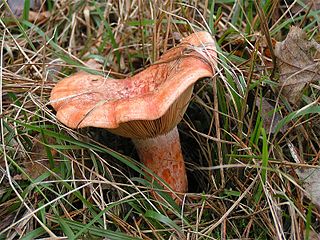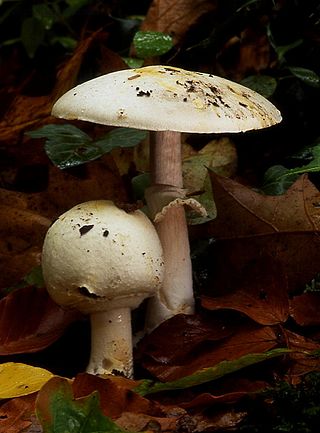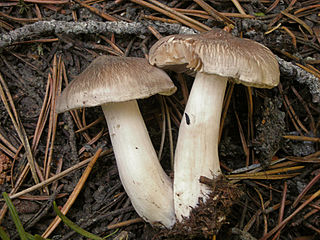
Hypholoma fasciculare, commonly known as the sulphur tuft or clustered woodlover, is a common woodland mushroom, often in evidence when hardly any other mushrooms are to be found. This saprotrophic small gill fungus grows prolifically in large clumps on stumps, dead roots or rotting trunks of broadleaved trees.

Lactarius deliciosus, commonly known as the delicious milk cap, saffron milk cap and red pine mushroom, is one of the best known members of the large milk-cap genus Lactarius in the order Russulales. It is native to Europe, but has been accidentally introduced to other countries along with pine trees, with which the fungus is symbiotic.

Tricholoma is a genus of fungus that contains many fairly fleshy white-spored gilled mushrooms which are found worldwide generally growing in woodlands. These are ectomycorrhizal fungi, existing in a symbiotic relationship with various species of coniferous or broad-leaved trees. The generic name derives from Ancient Greek: τριχο-, romanized: tricho-, lit. 'hair' and Ancient Greek: λῶμα, romanized: loma, lit. 'fringe, border' although only a few species have shaggy caps which fit this description.

Tricholoma equestre or Tricholoma flavovirens, commonly known as the man on horseback or yellow knight is a widely eaten but arguably toxic fungus of the genus Tricholoma that forms ectomycorrhiza with pine trees.

Tricholoma magnivelare, commonly known as the matsutake, white matsutake, ponderosa mushroom, pine mushroom, or American matsutake, is a gilled mushroom found East of the Rocky Mountains in North America growing in coniferous woodland. These ectomycorrhizal fungi are typically edible species that exist in a symbiotic relationship with various species of pine, commonly jack pine. They belong to the genus Tricholoma, which includes the closely related East Asian songi or matsutake as well as the Western matsutake and Meso-American matsutake.

Tricholoma pardinum, commonly known as spotted tricholoma, tiger tricholoma, tigertop, leopard knight, or dirty trich, is a gilled mushroom widely distributed across North America, Europe, and parts of Asia. It is generally found in beech woodland in summer and autumn. Two subspecies have been described from southern Europe. First officially described by Christiaan Hendrik Persoon in 1801, T. pardinum has had a confusing taxonomic history that extends over two centuries. In 1762, German naturalist Jacob Christian Schäffer described the species Agaricus tigrinus with an illustration corresponding to what is thought to be T. pardinum, and consequently, the name Tricholoma tigrinum has been used erroneously in some European field guides.

Clitocybe nebularis or Lepista nebularis, commonly known as the clouded agaric, cloudy clitocybe, or cloud funnel, is an abundant gilled fungus which appears both in conifer-dominated forests and broad-leaved woodland in Europe and North America. Appearing in Britain from mid to late autumn, it is edible, but may cause gastrointestinal issues.

Agaricus silvicola, also known as the wood mushroom or woodland agaricus, is a species of Agaricus mushroom related to the button mushroom. A. silvicola is a member of Agaricus section Arvenses, a group of morphologically similar mushrooms. A. silvicola, like other species in Agaricus section Arvenses, exhibits a positive Schäffer's reaction and potassium hydroxide reaction, and smells of almonds or anise.

Hydnellum aurantiacum is an inedible fungus, commonly known as the orange spine or orange Hydnellum for its reddish orange or rusty red colored fruit bodies. Like other tooth fungi, it bears a layer of spines rather than gills on the underside of the cap. Due to substantial declines in sightings, this species is listed as critically endangered in the United Kingdom.

Tricholoma terreum, commonly known as the grey knight or dirty tricholoma, is a grey-capped mushroom of the large genus Tricholoma. It is found in coniferous woodlands in Europe, and has also been encountered under introduced pine trees in Australia and New Zealand. It is regarded as edible. A 2014 article speculated that it may be poisonous, but Sitta et al. in 2016 published in the same journal a counter article demonstrating the unfounded nature of such speculation.

Ampulloclitocybe clavipes, commonly known as the club-foot or club-footed clitocybe, is a species of gilled mushroom from Europe and North America. The grey brown mushrooms have yellowish decurrent gills and a bulbous stalk, and are found in deciduous and conifer woodlands. Although considered edible, disulfiram-like reactions have been reported after consumption of alcohol after eating this mushroom.

Tricholoma saponaceum, also known as the soap-scented toadstool, soapy tricholoma, soapy knight or soap tricholoma is an inedible mushroom found in woodlands in Europe and North America.

Cystolepiota bucknallii is a species of basidiomycete fungus of the genus Cystolepiota. Found throughout Europe, it is a rare fungus occurring in deciduous forests. The small fruit bodies bear a distinctive smell of coal gas and appear in autumn on damp ground. It is not an edible mushroom.

Hygrophorus hypothejus, commonly known as the olive-brown waxy cap, or herald of the winter, is an edible species of fungus in the genus Hygrophorus native to Europe. It appears in late autumn in coniferous forests, often with the first frosts.

Tricholoma portentosum, commonly known as the charbonnier, streaked tricholoma, or sooty head, in North America, is a grey-capped edible mushroom of the large genus Tricholoma. It is found in woodlands in Europe and North America.

Tricholoma virgatum, commonly known as the ashen knight, is a mushroom of the agaric genus Tricholoma. It was first described scientifically as Agaricus virgatus by Elias Fries in 1818, and later transferred to the genus Tricholoma by Paul Kummer in 1871. It is found in the deciduous and coniferous forests of Europe, North America, and China. The mushroom is inedible, speculated to be poisonous, and has a bitter and peppery taste and musty odor.

Tricholoma ustale, commonly known as the burnt knight, is a species of mushroom in the large genus Tricholoma. It is found in Asia, Europe, and North America, though those from North America may represent one or more different species.

Tricholoma inamoenum is a mushroom of the agaric genus Tricholoma found through the Northern Hemisphere, particularly under conifers. It is poisonous, and is characterized by an unpleasant odor resembling coal gas or tar. • Analysis of the volatile compounds emanating from fresh sporocarps using solid phase microextraction (SPME) showed the odor compounds responsible for the coal tar odor of this mushroom are 1-octen-3-ol and indole.

Tricholoma sejunctum is a mushroom that appears across much of the Northern Hemisphere and is associated with pine forests.



















